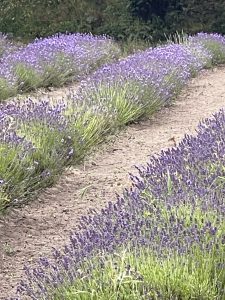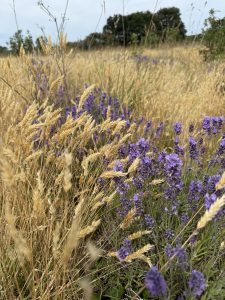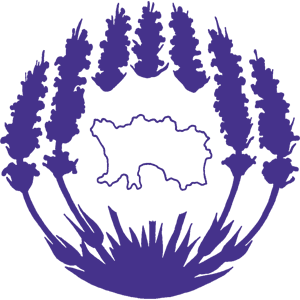 The Jersey Lavender season is winding down, lavender oil distilled, along with bay laurel. Lavender flowers gathered, they need to be dry for bags, and culinary uses.
The Jersey Lavender season is winding down, lavender oil distilled, along with bay laurel. Lavender flowers gathered, they need to be dry for bags, and culinary uses.
Hand-made lavender bags – instructions…
To make bags, the best time to cut the seed heads is when the lavender flowers are over and the seeds are purple or just turning grey. The fragrance is beginning to fade then, so don’t leave it much longer. Cut on a dry day, and check the seed heads are dry.
Separate the seeds from the stalks. They can disperse all over the place, so remove the seeds inside a container. Cut two rectangles from your chosen fabric, hessian, gingham, and simple plain coloured cotton works well. Size depends on your preference, which may depend on whether you are using scraps of fabric. Pop one rectangle on top of the other, face down, and pin in place. Sew around three edges, leaving one of the shorter edges open. Trim the seeds if needed, and cut the corners off. Turn the pocket the right way out. Fill the bag with lavender about two thirds full. Now, fold in the raw edges, and hand sew the opening securely. You might like to embroider the bag, decorating with a lavender motif. Get creative, make your own signature style!
A new field was planted up this spring, with small lavender plants, of Grosso and French lavender, a further stage to replenish and regenerate the lavender stocks. It’s a slow process, each season different. The weather this year was hot and dry, with very little rain. Luckily lavender thrives in such conditions, being a hardy plant originally from the Mediterranean.
Since taking over the farm in 2019, the present owners have faced a few challenges, with unexpected events and storms of varying kinds. However, foundations are strong, and resilient, so although the initial plans for regeneration have had to be pushed back, slowly, the farm is transforming, and in a few years, it is hoped that once more the fields will be brimming with a purple hue.
In the meantime, the golden grasses and lavender blues in the wildflower meadow delighted many who followed the paths out beyond the main lavender fields. Among the, wild carrot, evening primrose, mullein, dandelions, clover, centaury, and other wildflowers, the bees and butterflies, as well as moths flitted and danced among the flowers. This diversity amongst the grasses is needed, to maintain soil health, as well as to create a biodiverse ecosystem which supports the growth of the lavender.
Lavender plants are aromatic, drought-tolerant garden plants. This shrub thrives in a sunny spot in the garden, in free-draining soil or a container.
The lavender oil distilled this summer will be stored for at least six months, before bottling, as the fragrance matures over time.
The farm’s products are available in the shop for a little while longer, and then once the farm closes, you are still able to purchase your favourites from the online store.
Amanda wishes to thank the many visitors to the farm who joined her tours, in which she shared her love and passion for nature, herbs and wildflowers.

See you next year!

